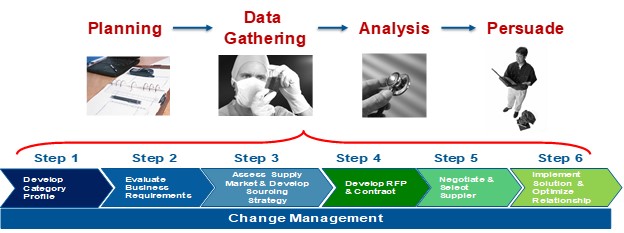I have spent the last several weeks training a client on how to “sell” their recommendations to their internal Stakeholders. As Sourcing / Category Management / Supply Chain professionals we ARE playing the role of an internal consultant (whether we recognize it or not). To be effective in that role, we must integrate the consulting process into our business process – here is a simple illustration utilizing a Strategic Sourcing process (they are all basically the same):
This intersection of the consulting process and the Sourcing or Category Management process is what separates strong Category Management professionals from weaker ones. In commercial consulting firms (like the Big 4) their consultants are taught the consulting process first (Planning, Data Gathering, Analysis, Persuade) and then expected to apply it to ANY business process that they are working with. If you have ever worked with a consulting firm, their objective is to convince (persuade) the client to act on the recommendations they develop in the Analysis step. The client only benefits from the analysis WHEN they ACT. So, the Persuade step is the most critical.
Think about your role as a Sourcing / Category Management professional. Your job is to get your internal business partner to implement (ACT) your recommendations. Please keep in mind, the best solution, founded on the most in-depth research and the deepest analyses, is worth nothing if the “customer” does not understand it, accept it, and act on it and ADOPT it. The persuade step is ALL about communication and storytelling is one very powerful way of conveying your message.
I read an article in HBR, “Storytelling Can Make or Break Your Leadership” and it got me to thinking about how effective “the story” is in getting your audience to ACT. At The Mpower Group we do a lot of training for Category Management professional and leadership teams. One bit of feedback I always get is to “keep providing “stories” of your past experience”. I always enjoyed telling stories because it was a comfortable way for me to communicate my message in a relaxed format that got my audience to listen. The author notes, “ Telling a compelling story is how you build credibility for yourself and your ideas. It’s how you inspire an audience and lead an organization. Whether you need to win over a colleague, a team, an executive, a recruiter, or an entire conference audience, effective storytelling is key.” He provides some tips on the elements of an effective story:
- Be audience-specific – When you are crafting your story, you need to understand what will motivate your audience to ACT. Think about their concerns, curiosities and motivators and that will help you to develop your message and determine the specific words that will resonate.
- Contextualize your story – Remember one simple rule “Context ALWAYS Trumps (not Donald) Content”. You must make help your audience understand how your story is connected to what they need to do – what is important to them or how it will benefit them.
- Humanize your story – Personal anecdotes can really make a story become real. Every Spring I write a blog entitled “Shop your Closet”. It’s a story about me buying yet another plain black skirt when I already had over a dozen in my closet. If I had started by looking through my closet first, I would realize that buying another plain black skirt is foolish – I already own many to choose from. It is similar to a company buying a new P2P system because they think a new one will be better than the one they already have BUT the issue is not the current system, it is the lack of Adoption of the features of the current system – hence, shop your closet. This story is an interesting way to get your audience to connect the dots.
- Make it action-oriented – Your stories should focus on exactly what actions you need your audience to take
- Keep it humble – Discuss both successes and failures. Sharing lessons learned can many times be more compelling / real than always painting a rosy picture.
The next time you need to do a presentation or put forth a recommendation, try out the storytelling technique. It takes practice to get good at it so start now. It can have major impact on the way you present yourself as a professional to your internal business partners and add to your credibility. As the author notes, “It will take practice, but when done well, good storytelling can make a major impact on your team, your organization, and your entire career”.


